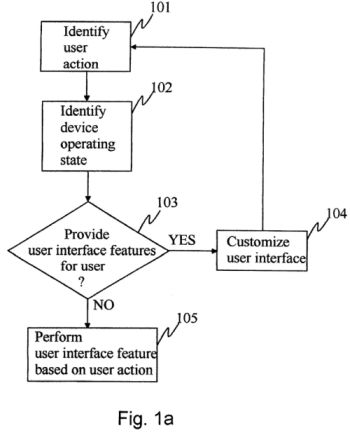- within Intellectual Property topic(s)
This decision relates to an Opposition appeal against a granted European patent that concerns providing an option on a user interface with an aim to simplify and speed up the use of a device. The Board considered that dynamically offering a user interface option in response to an image been captured during a telecommunication connection with another device credibly assists the user in quickly sending the captured image information to the other device. This avoids the need to select the captured image information from the memory and to specify data identifying the other device. Here are the practical takeaways from the decision T 0282/17 of December 15, 2021 of Technical Board of Appeal 3.5.04:
Key takeaways
- Offering the user of a telecommunication device an option in response to image information having been captured during a telecommunication connection with another device credibly assists the user in quickly sending the captured image information to the other device by avoiding the need to select the captured image information from the memory and to specify data identifying the other.
- Dynamically offering a user selectable option in response to a determination that certain conditions are met is technical.
- Improving the sending of image information from one device to another is a technical problem.
The invention
The invention relates to a method and a system to simplify and speed up the use of a telecommunication device in connection with sending various kinds of multimedia messages from one device to another advantageously when the device is in communication connection with the other device.
For example, when a user takes an image with a camera of the device, the device identifies the mode of the device at that moment (is a call active or not) and provides a user interface with having the possibility to send the taken image straight to the device with which the communication connection had been made (for example, from A-subscriber to B-subscriber).

Fig. 1a of EP 1 755 328 A1
Claim 1
A method comprising: establishing a wireless telecommunication connection between a first telecommunication device and another telecommunication device,
- creating, using a camera, image information in the first telecommunication device during the telecommunication connection to the another telecommunication device;
- offering on a user interface of the first telecommunication device, in response to a determination that image information has been created using the camera during said telecommunication connection, a user selectable option to send the created image information from the first telecommunication device to the another device with which the telecommunication connection has been established; and
sending, in response to user selection of the user selectable option, the created image information from the first telecommunication device to the another device, while the telecommunication connection between the first telecommunication device and the another telecommunication device is still active.
Is it patentable?
The first-instance Opposition Division found that the subject-matter of claim 1 was inventive. The Opponent appealed the decision and alleged, in addition to other objections, that the subject-matter lacked novelty over the disclosure of E1 (EP 1 148 725 A2), or at least, lacked an inventive step starting with document E1 and common general knowledge.
According to the Opponent-Appellant, document E1 is related to a videophone apparatus taking a live picture of the user and provides the two keys which when pressed capture a live picture for the videophone. This implicitly disclosed the case where image information was sent after one of the keys was pressed.
The Board did not agree with this argument of the Opponent-Appellant, and in agreeing with the Patentee-Respondent agreed that the subject-matter was novel for the following reasons:
6.2 The board agrees with the respondent that, when interpreted properly in the context of the patent, claim 1 specifies dynamically offering a user selectable option in response to a determination that certain conditions are met (see point XIX.(a) above). Interpreting claim 1 as encompassing the case where the user selectable option was offered permanently (see appellant's argument under point XIX.(e) above) would mean that the expression "in response to a determination that image information has been created using the camera during said telecommunication connection" would have no limiting effect on its subject-matter. This would be inconsistent with the embodiments of the description, which all teach automatically triggering the offering of a user selectable option once it is determined that the user has captured image information and that the device is in a state of data connection with another device (see the description of steps 101 to 103 of Figure 1a and steps 111 to 113 of Figure 1b in the passage from page 2, line 24 to page 4, line 6 of the application as filed and paragraphs [0015] and [0016] of the patent, as well as the paragraph bridging pages 6 and 7 of the application as filed and paragraph [0021] of the patent).
6.3 The board agrees with the opposition division (see point 15.1 of the decision) and the respondent (see point XIX.(b) above) that the offering of the two keys 111b and 111c described in document E1 is not dynamically triggered by the creation of image information during the telecommunication connection. These keys are always available on the user interface and can be pressed by the user at any time to trigger the sending of either a live picture (key 111b) or a processed picture (key 111c). The last sentence of paragraph [0101] of E1, referred to by the appellant (see point XIX.(f) above), merely describes the possibility that the user can start sending their live picture when they are ready to show themselves to their interlocutor.
The Opponent-Appellant then argued that the distinguishing feature of dynamically offering a user interface is not inventive as it merely relates to providing a soft button graphical user interface instead of a physical key.
The Board disagreed, and in agreement with the Patentee-Respondent acknowledged that the feature is technical:
7.3 The board disagrees with the appellant that the only technical effect achieved by the features identified under point 6.5 above is that the offering is represented not by a physical key but by a soft button on a graphical user interface (see point XX.(a) above). Offering the user of a telecommunication device an option in response to image information having been captured during a telecommunication connection with another device credibly assists the user in quickly sending the captured image information to the other device by avoiding the need to select the captured image information from the memory and to specify data identifying the other device.
7.4 The technical background of the patent is a telecommunication device establishing a voice connection with another device (see paragraph [0003]). As stated in paragraph [0010] of the patent, the purpose is to simplify and speed up the sending of various kinds of multimedia messages from one device to another when the device is in communication-connection with the other device. As indicated under point 7.3 above, this problem is solved by the subject-matter of claim 1.
7.5 In view of this, the board finds it justified to formulate the objective technical problem as improving the sending of image information from one device to another, as proposed by the respondent (see point XX.(d) above).
7.6 The board agrees with the respondent (see point XX.(g) above) that even if it were to be considered obvious to replace the physical keys described in E1 with software keys and to dynamically offer the software keys on the basis of the conditions specified in claim 1 (see the appellant's arguments under point XX.(b) and (c) above), the person skilled in the art would have found no prompt in E1 to modify the functionality of the software key in such a way that selecting it triggered the sending of the retrospective image information whose creation generated (or activated) the software key, as required by claims 1 and 4 of the revised second auxiliary request.
7.7 This reason is sufficient to arrive at the conclusion that the subject-matter of claims 1 and 4 involves an inventive step in view of the disclosure of document E1 combined with the common general knowledge of the person skilled in the art.
Therefore, claim 1 was considered to involve an inventive step, and the appeal is allowed with an order to maintain the patent (in amended form).
More information
You can read the whole decision here: T 0282/17 of December 15, 2021, of Technical Board of Appeal 3.5.04
The content of this article is intended to provide a general guide to the subject matter. Specialist advice should be sought about your specific circumstances.


